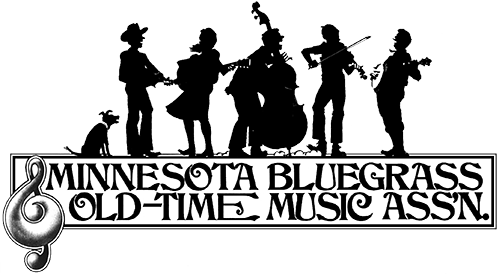|
- Home
- About our Music
About Our Music
Our mission is to preserve and promote bluegrass and old-time string band music in and around the state of Minnesota.
But exactly what does that mean? First of all, our emphasis is generally on acoustic music played on string instruments such as fiddle, banjo, guitar, mandolin, and bass. You’ll hear traditional fiddle tunes, old “folk” songs, classic bluegrass from the 1950s onward, as well as brand new songs and newly-composed instrumentals.
Our association also welcomes “related” forms of acoustic music – Cajun, Celtic, folk, swing, Dixieland, country, roots, and the like!
What is Bluegrass music?
The history of bluegrass music begins with the people who migrated to America in the 1600s from Ireland, Scotland, and England and brought with them basic styles of music that are generally considered to be the roots of modern bluegrass music. As the Jamestown settlers began to move out into North and South Carolina, Tennessee, Kentucky, Virginia, and West Virginia, they wrote songs about day-to-day life in the new land. Since most of these people lived in remote areas, the songs reflected life on the farm or in the hills. This music was referred to as country music or mountain music. The invention of the phonograph and the onset of radio in the early 1900s brought this music out of the mountains and into the homes of people all over the United States.
Bluegrass features acoustic string instruments and emphasizes the off-beat. Notes are anticipated, in contrast to laid back blues where notes are behind the beat, which creates the higher energy characteristic of bluegrass. In bluegrass, as in some forms of jazz, one or more instruments each takes its turn playing the melody and improvising around it, while the others perform accompaniment; this is especially typified in tunes called breakdowns.This is in contrast to old-time music, in which all instruments play the melody together or one instrument carries the lead throughout while the others provide accompaniment. Breakdowns are often characterized by rapid tempos and unusual instrumental dexterity and sometimes by complex chord changes.
There are three major subgenres of bluegrass. Traditional bluegrass has musicians playing folk songs, tunes with traditional chord progressions, and using only acoustic instruments, with an example being Bill Monroe. Progressive bluegrass groups may use electric instruments and import songs from other genres, particularly rock & roll. Examples include Punch Brothers, Cadillac Sky and Bearfoot. Another subgenre, bluegrass gospel, uses Christian lyrics, soulful three- or four-part harmony singing, and sometimes the playing of instrumentals. A newer development in the bluegrass world is Neo-traditional bluegrass; exemplified by bands such as The Grascals and Mountain Heart; bands from this subgenre typically have more than one lead singer. Bluegrass music has attracted a diverse following worldwide.
What is Old Time music?
Old-time music was the old-time name for real mountain-type folk music. Old-time music is the main foundation for bluegrass music. It is the kind of music that Bill Monroe, Earl Scruggs, the Stanley Brothers and in fact most rural people prior to the mid nineteen twenties, were raised with. It is the old unaccompanied English ballads like Barbara Allen, new American songs like Wild Bill Jones, old fiddle tunes like Devil's Dream, and newer banjo tunes like Cumberland Gap. It's a rich and varied heritage of music - as rich as the roots music of any country. It was played throughout rural America but was extra strong and distinctive in the Southeast, especially in the mountains. It is sung and played on a variety of acoustic instruments including the guitar and mandolin which were newcomers to it in the early twentieth century
Old-time music is played using a wide variety of stringed instruments. The instrumentation of an old-time group is often determined by what instruments are available, as well as by tradition. The most common instruments are acoustic string instruments. Historically, the fiddle was nearly always the leading melodic instrument, and in many instances (if no other instruments were available) dances were accompanied only by a single fiddler, who often also acted as dance caller.
By the early 19th century, the banjo had become an essential partner to the fiddle, particularly in the southern United States. The banjo, originally a fretless instrument made from a gourd,[citation needed] provided rhythmic accompaniment to song, dance and the fiddle, incorporating a high drone provided by the instrument's short "drone string." The banjo used in old-time music is typically a 5-string model with an open back (i.e., without the resonator found on most bluegrass banjos).
Today old-time banjo players most commonly utilize the clawhammer style, but there were numerous styles, most of which are still used to some extent today. The major styles are down-picking (generally referred to today as "clawhammer," though historically myriad names were used to describe it), two-finger index lead, two-finger thumb lead, and a three-finger "fiddle style" that seems to have been influenced in part by late-19th century urban classical style. Young players might learn whatever style a parent or older sibling favored, or take inspiration from phonograph records, radio, traveling performers and migrant workers, local guitarists and banjo players, as well as other musicians they met when traveling to neighboring areas. Having a fiddle play the lead melody with a banjo playing rhythmic accompaniment is the most common form of Appalachian old-time music today.
Individualistic three-finger styles were developed independently by such important figures as Uncle Dave Macon, Dock Boggs, and Snuffy Jenkins. Those early three-finger styles, especially the technique developed by Jenkins, led to the three-finger Scruggs style created by Earl Scruggs in the 1940s, which helped advance the split between the old-time genre and the solo-centric style that became known as bluegrass. Jenkins developed a three-finger "roll" method that, while obviously part of the old-time tradition, inspired Scruggs to develop the smoother, faster and more complex rolls that are now standard fare in bluegrass music.
In the 19th and early 20th centuries, musicians began to add other stringed instruments to the fiddle-banjo duo—including guitar, mandolin, and double bass (or washtub bass). These provided chordal, bass line, and pitched rhythmic accompaniment, and occasionally took over the melody, usually during a "break" section that lasted the duration of a verse, refrain, or verse and refrain. This, along with a Dobro (resonator guitar), is also considered 'standard' bluegrass instrumentation, but old-time music tends to focus on sparser instrumentation and arrangements compared to bluegrass. Such an assemblage, of whatever instrumentation, became known simply as a "string band." Less frequently used are the cello, piano, hammered dulcimer, Appalachian dulcimer, tenor banjo, tenor guitar, lap-steel guitar, mandola, mouth bow, as well as other instruments such as the jug, harmonica, autoharp, jaw harp, concertina, button or accordion, washboard, spoons, or bones.
The fiddle is sometimes played by two people at the same time, with one player using the bow and fingers, while another player stands to the side and taps out a rhythm on the fiddle strings using small sticks called fiddlesticks (also spelled "fiddle sticks"). This technique (also sometimes called "beating the straws") is utilized in performance most notably by the duo of Al and Emily Cantrell.
Each regional old-time tradition accompanies different dance styles. Some of these include clogging and flatfoot dancing (Appalachia), contra dancing (New England), square dancing (Southern states) and step dancing (Nova Scotia, particularly Cape Breton Island), though there is some overlap between regions.


